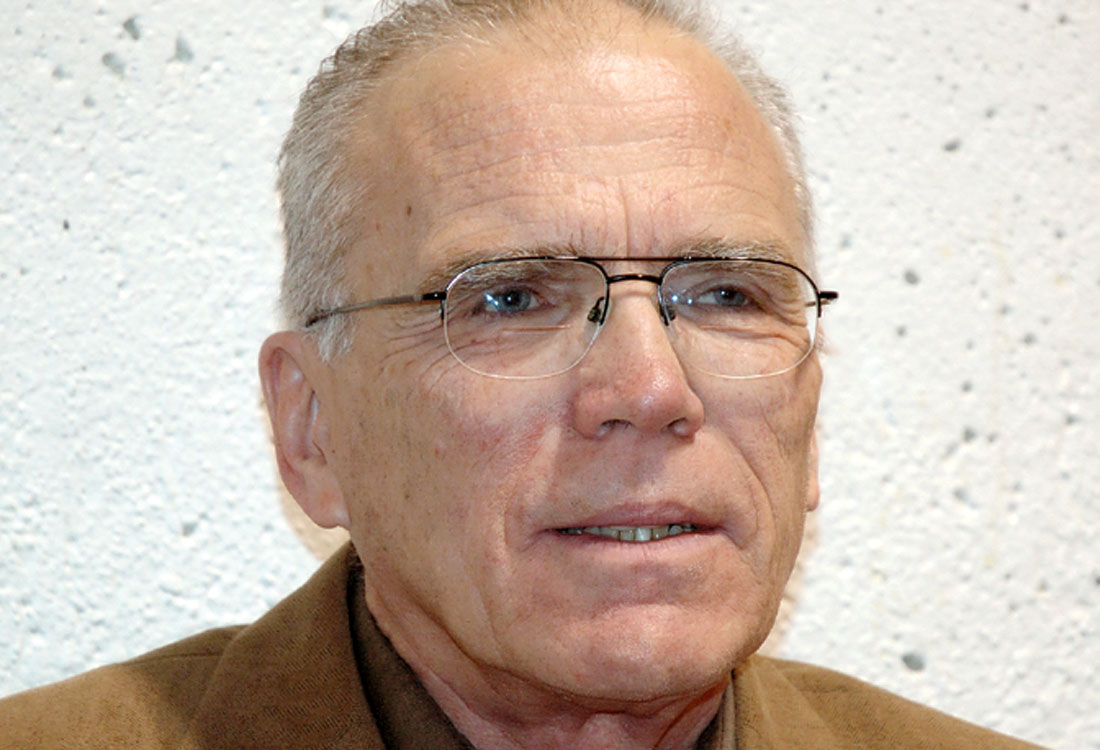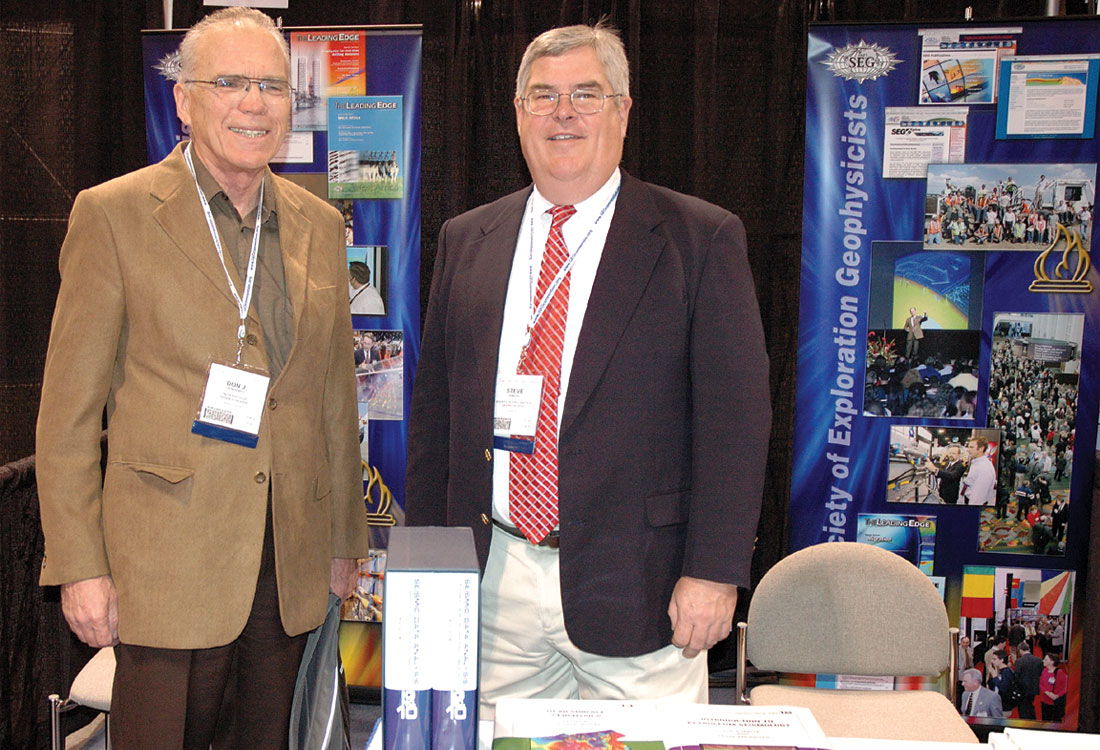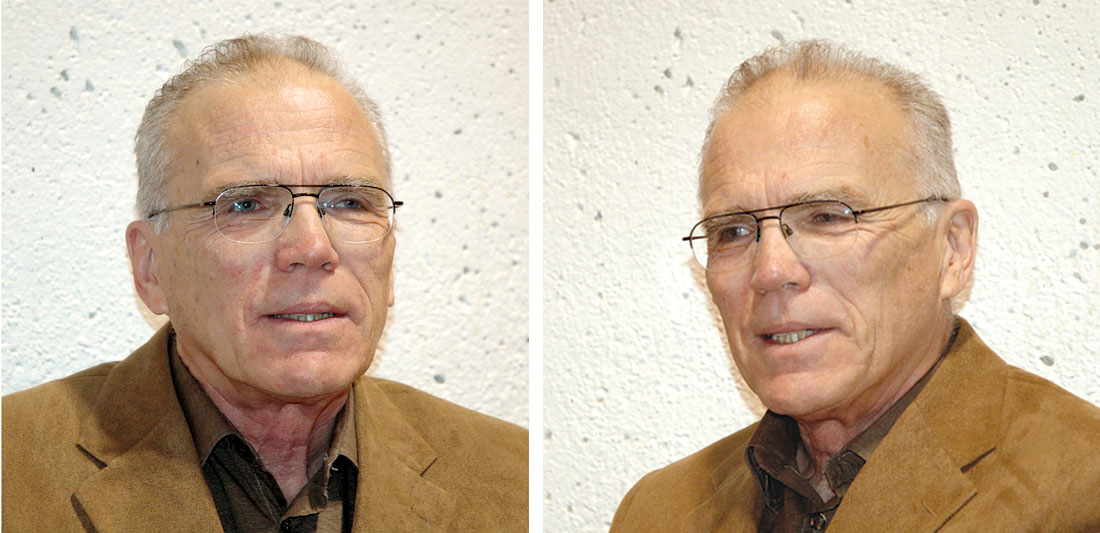
Dr. Don Gendzwill is an Emeritus Professor at the University of Saskatchewan since 1999. He joined the University in 1969 and continues to do research, consulting and occasionally teaching.
Don and Dr. Zoltan Hajnal put together a new geophysics program in the early 1970's which they continuously improved and updated. This program facilitated the progression of many University of Saskatchewan students to successful geophysical careers all over the world. Don's lectures reflected careful preparation and respect for his students.
Satinder Chopra met with him during Dr. Gendzwill’s visit to Calgary for the 2007 CSEG/CSPG joint convention. Following are excerpts from the interview.
Please tell us about your educational background and your work experience?
My Bachelors degree was in Engineering Physics at Michigan College of Mining and Technology, 1957, a good engineering school close to my home town. Master’s was also from Michigan Tech in 1958 with a thesis on induced polarization. I worked for Cominco in mining exploration for five years, then moved to Saskatoon with the Saskatchewan Research Council, enrolling part time in Grad studies at the University of Saskatchewan. After my PhD I was hired by the Department of Geological Sciences to teach the geophysics program in 1969. In 1999 I became a Professor Emeritus and continued with research, some consulting, and sometimes teaching my old Well Logging class.
How come this switch from Engineering Physics to Geophysics? I notice you got your Master’s after just one year. How was that?
Michigan Tech did not have an undergraduate geophysics program at that time but I wanted to get into geophysics because of the science and outdoor activities. I had a hard time identifying minerals so geology was not my choice. The path recommended by my advisor, Lloyal Bacon, was to get a degree in Engineering Physics and Masters in geophysics. At that time a one year M.Sc. was the usual thing.
What research did you carry out for your Ph.D. in Geophysics?
I did a gravity study in the Flin Flon area under Dr. Ken Burke, who moved to U. of Manitoba just before I finished. He later went to U. of New Brunswick.
Tell us about the different types of problems in Geophysics that you have worked on? What areas of Geophysics interest you the most and why?
With Cominco I did mostly ground magnetics and EM exploration for base metals. With the SRC it was surface and down-hole resistivity for groundwater, and the gravity work near Flin Flon. I also did some seismic work for potash mines. With the university I continued underground and surface seismic applications for mining and engineering purposes. I developed equipment for upward looking seismic reflection surveys in the mines. When the potash mines started generating earthquakes I began seismic monitoring programs both on surface and underground. I did a little ground probing radar. It’s all interesting.
In the last 37 years that you have been teaching at U of S, tell us about the changes that you have noticed in terms of students that have been coming, changes in the Dept. of Geological Sciences, U of S, or other type of changes you may have perceived?
Our geophysics undergraduate students come mostly from Saskatchewan, with a few from Alberta and elsewhere in Canada. Many have farm backgrounds and we think this gives them an advantage because they know how to do things and work with equipment. Some of our graduate students are also from Saskatchewan and Canada but we have a lot from overseas. We never had a lot of students; the highest number was 12 in 1982. Brian Russell was in a class of 2, so I guess numbers are not the whole story.
In terms of change, when I started, the geology program was very classical with emphasis on mineralogy, petrology, economic geology. Geophysics was an add-on that was just tolerated by the old time geologists, but it gradually grew. The first geophysics professor was Don Hall in the early 1960’s, who went to U. of Manitoba and eventually retired there. The next was a young Englishman, Ken Burke, from Leeds, who was my supervisor. He too went to Manitoba then to the University of New Brunswick where he retired. I filled in 1969/1970 the year Ken left. The department head, Rod Byers, then asked me if I would take the job permanently. I said yes, if they would hire another geophysicist, and that is how Zoli Hajnal got hired. We designed a new geophysics program and put in a 2 week field school which was not very common in those days. For 12 or 13 years the University of Alberta geophysics students came to Saskatoon to participate in our field school, first with Edo Nyland, then with Doug Schmitt. Jim Merriam was hired in 1985 so then we had three geophysics professors. I took retirement in 1999 and Sam Butler was hired in 2001 Zoli took retirement in 2002 and Igor Morozov was hired in 2003, so we now have three full time and two emeritus geophysics professors.
Over the years we have changed and adapted the program as technology grew. We now have a very comprehensive computer center and research interests in many areas.

How do you look back on your life and career? Is it a sense of satisfaction, fulfillment, or something else?
I am very satisfied with my career and can’t imagine doing anything else. I keep on doing it.
When you look back on your illustrious career, what were some of the successful landmarks?
A major landmark was getting my PhD at age 34 then starting with the university. An important association with the potash industry started in 1964 when I did my first underground seismic survey. Several significant publications dealt with Winnipegosis mounds and salt removal structures. I did the very first 3D survey for potash in 1986. One significant thing was the earthquake source location program using the downhill simplex that I published with Arnfinn Prugger in 1989. That algorithm is now used on almost all the mines with rock-burst problems. This year I published a paper with Mel Stauffer on faults in the Upper Cretaceous of central Saskatchewan, something new.
What about the ‘quantity’ and ‘quality’ of students coming to your department for research? Please tell us about that.
Ten graduate students finished their degree with my supervision. Now I have none. The Department now has about 34 registered graduate students; seven of them are in geophysics. We have some very good students. I don’t think they have changed in any fundamental way but modern students have to be a lot more knowledgeable about computer systems.
You have done a lot of work in potash mines. Tell us about potash mining in Saskatchewan, why it is important, how much of potash is produced, consumed within Canada and exported, etc.?
Fertilizers contain Nitrate, Phosphate, and Potassium, very important in agriculture. Potash is the source of potassium in the form of a mineral called sylvite, KCl. It is found in large amounts in the upper portion of the Prairie Evaporite Formation which underlies much of southern Saskatchewan. There are also mines in New Brunswick. About 18 million tonnes a year are produced for a sales value of around $2 Billion. Most of it is exported to the United States, China, South America, Europe and elsewhere. For historical reasons, the KCl potash mineral is marketed as K2O equivalent. Most Canadian soils do not lack potash so only about 10% is used in Canada. Potassium is also used in relatively small amounts in chemical processes, glass, etc. For people with high blood pressure, the potassium salt, sylvite, can be used in food instead of the common sodium salt, halite.
Most potash is mined at a depth of about 1000 m by underground systems using highly automated big boring machines and conveyor belts. The rock is crushed and a flotation method is used to separate the sylvite from halite. Some potash is mined by a solution process where sodium saturated brines are circulated underground, extracting the more soluble potassium ions. The brine is pumped to cooling ponds on surface where the potassium salt crystallizes out.
How did your work help in potash exploration?
We don’t usually explore for potash but we look for good mining conditions. Potash deposits are not exactly everywhere but they are very broad and uniform so the main objective of surface seismic programs is to find discontinuities in the known ore bodies where there would be some problem or hazard to the mining. In the early days of 2D this was mainly focused on identification of large salt removal structures such as the Colonsay Collapse, 3 km wide and 10 km long. Winnipegosis mounds have an indirect effect on the ore beds causing elevation changes, ore grade variations, and instability of the mine openings. Now 3D surveys allow mapping of chimney collapse structures with dimensions of a few tens of metres, potential water inflow hazards. Under good conditions we can even identify the presence of carnallite, a deleterious mineral. Water inflows are more dangerous in a potash mine than in a hard rock mine because the rock is soluble, so identification of possible water inflows is important. On a positive note, smooth, flat seismic reflections represent good mining conditions.
Underground seismic methods are used to measure the thickness of bedded salt above the mine and to identify structures in the overlying limestones. Ground probing radar is used to identify clay layers in the salt, fractures, and wet zones. We have experimented with gravity and resistivity methods. Downhole logging methods are used from surface boreholes and sometimes from horizontal underground holes.
On two occasions I was able to use seismic source location methods to verify the position of underground openings that were being driven toward each other from opposite directions. On one occasion a surface 3D survey determined that the position of the underground workings was mis-located by about 50 m, an error in the mine survey.

You are a senior Professor with U of S. What are your responsibilities? Is it just teaching or there is more to it?
Well, I am now a Professor Emeritus and no longer on the teaching staff. At my own pace I continue to do research, consulting, and sometimes teach a class, but I do not have to attend department or college meetings. Full time university professors are evaluated on the basis of teaching, research, administrative duties, and outreach, community or political work. Salary increases are often awarded for research, but the other categories are also important.
In your role as a senior Professor, and your long innings at the U of S, I would like you to comment on the campus politics that prevails in every university, big or small, and how it affects the teaching in the department and/or the students.
Campus politics revolves around budgets, academic programs, and the aims and objectives of the University. In the case of the professional groups such as Engineering, the requirements of the regulatory group tends to dominate the program. The Association of Professional Engineers dictates much of the curriculum, facilities, and professional qualifications of professors who must be P. Engs. In Saskatchewan earth scientists now fall under the Association of Professional Engineers and Geoscientists. This sometimes creates conflict when a high quality scientist does not have his P. Geo.
What is your impression about (a) the important developments that people can expect in geophysics in the near future (b) anything path breaking that we can expect that would revolutionize things, after the 3D seismic adoption in the 1980s and becoming a routine in early 1990s.
I am not directly involved in seismic research, but it seems that there is a steady improvement in quality and resolution of 3D seismic. If small systems with low cost can be implemented there may be opportunity to extend the methods to new areas, such as tunneling studies, foundations of large buildings, etc. Also, I am impressed with developments in offshore electrical sounding and integration with marine seismic methods. There may be dramatic developments there, possibly combining with electroseismic methods. Remote evaluation of physical properties of rock through logging methods and seismic estimations is important.
Apart from the journal publications, have you published your work in the form of any book?
I don’t have any books, only chapters in a few books. Probably the best is with Ralph Lundberg in the CSEG Geophysical Atlas, 1989.
What is your impression about the current state of the Canadian universities, in general and then with respect to Geophysics in particular? How do they compare with other North American and European universities? You may also like to include in terms of the funding, problem-oriented research, dearth or abundance of students, etc.
I think the Universities will face continuing problems of increasing enrollments and insufficient budgets. Qualified people are in short supply and we are in competitions with industry for them. Rapid growth of technology makes the professors job more complicated and it squeezes academic programs because universities are hard pressed to keep up with expensive equipment.
People say we should focus on “the Basics” but what are “the basics”? When I went to school, all the engineers took drafting with compass and straight edge. It was important then, but not now. My alma mater did a survey a couple of years ago asking if graduate engineers considered Calculus a requirement. Most did not, but most are not in research. So what is needed for a competent graduate, and is a four year program enough? These decisions are a challenge.
How about University of Saskatchewan? What sets it apart from other universities? What is it that would attract students to come and work here?
The University of Saskatchewan has an excellent Geology building, new in 1987, and infrastructure. We have a first rate computer system. The Canadian Light Source synchrotron is on campus and used extensively by earth scientists. We have arguably the best analytical isotope geochemistry labs of any Canadian university. We have a complete rock mechanics laboratory for all standard and many non-standard tests. Our geophysics field school program is still going strong and expanding with new equipment. Our alumni have an excellent reputation in Calgary and elsewhere. Our faculty is dedicated and very research intensive. We have strong student geophysical and geological societies. This year is the 100th anniversary of the University of Saskatchewan. We are planning a Homecoming Celebration September 14-16 and I invite all Geology/Geophysics Alumni to attend.

What other interests do you have?
I have a wife and four children, all married and living nearby. We often get together with the grandchildren. I’m a good downhill skier but don’t get out to the mountains often enough. I like to read history. My wife and I joined a square dance club a few years ago. We travel every year. Last year we did the Alaska Cruise and also drove around Lake Superior. Saskatoon has some good theater. I make wine from kits. I’m a lousy golfer.
What would be your message for young entrants to geophysics? What are most rewarding aspects of taking up a career in geophysics?
Geophysics combines challenging features of geology, math, physics, and computers. You can always learn. I think the greatest reward is the thrill of discovery, whether it’s an economic deposit or a scientific phenomenon.











Share This Interview